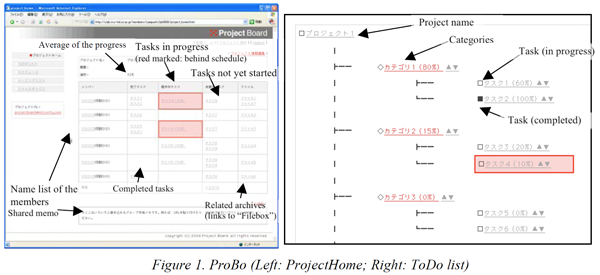ProBo: Project-Based Learning Groupware for Undergraduate Education
In recent years, project-based learning (PBL) is being extensively used as a major educational method in higher education (Gijbels et al., 2005). PBL is a type of learning activity in which learners study along with other learners whilst working toward a common goal and collaborating on tasks as a group. This trend results from the fact that undergraduate students are expected to enhance their creativity and social skills before they graduate and commence participating in society.
Throughout the PBL, learners rarely perform the same task simultaneously. They prefer to divide a certain part of the task into smaller tasks and allocate each task to individual group members. Even in cases wherein the rules for the division of labor are institutionalized by a teacher or an organization, people sometimes cross the borders of the division and coordinate their tasks across these borders with other people, as the occasion may demand. For instance, if the task monitor provides a task performer some instructions and then notices the task performer’s errors, it implies that the monitor becomes involved in performing the task. Thus, the division of labor is reorganized in a more or less ad lib and ad hoc manner such that the task progresses uninterrupted and error free (Hutchins, 1990). Kato et al. (2004) termed such a crossover of division of labor as the “emergent division of labor (EDL)” and argued that EDL should provide extensive opportunities for learning wherein scaffolding (Wood et al., 1976) takes place naturally.
The Web-based groupware for PBL called “ProBo” (formerly “Project Board”) has been developed in order to help learners assess the current division of labor in a project-based learning and plan and reorganize its next step by themselves. ProBo has been designed to visualize and allocate tasks among the learners, and to share files among those learners during PBL. ProBo has the following four features: (1) ProjectHome, which indicates the manner in which the learners should organize their division of labor and the progress of their respective tasks; (2) the ToDo list, which presents the structure of the tasks in the form of a tree diagram; (3) the Scheduler, which allows the learners to confirm the schedule for each task, the deadline which needs to be scheduled; and (4) FileBox, which stores the files pertaining to the tasks. Learners can communicate with each other pertaining to every task, file, and the whole of the project using the memo function.

This system is distributed for free at http://pb.code.u-air.ac.jp (available only in Japanese). The system was developed with Java Struts and it works with JDK1.4 or higher and MySQL 4 or higher on Apache Tomcat.
Researchers
- Hiroshi Kato (Principal Researcher): National Institute of Multimedia Education
- Toshihisa Nishimori (System Architecture): Natinal Institute of Multimedia Education
- Toshio Mochizuki (Concept making, Evaluation): Information Science and Technology Center, Kobe University
- Kazaru Yaegashi (Information Design): Department of Human Cultures and Sciences, Fukuyama University
- Shin-ichi Hisamatsu (Development): Articulate, Inc.
- Shigeto Ozawa (Evaluation): Yasuda Women’s College
Acknowledgement
This research was supported by Grant-in-Aids for Exploratory Research (Subject No. 15650171, representative: Hiroshi Kato) and and Grant-in-Aid for Scientific Research (B) (Subject No. 19300290, representative: Hiroshi Kato) from the Japanese Ministry of Education, Culture, Sports, Science and Technology.
References in English
- Mochizuki, T., Kato, H., Nishimori, T., Hisamatsu, S., Yaegashi, K. & Ozawa, S. (2005). A Design of Self-Assessment Environment in Project-based Learning: Monitoring and Reorganizing Tasks and Division of Labor. In Proceedings of the 6th Annual International Conference on Information Technology Based Higher Education and Training 2005 (CD-ROM Proceedings). Paper presented on July 8, 2005, in Juan Dolio, Dominican Republic, IEEE.
- Nishimori, T., Kato, H., Mochizuki, T., Yaegashi, K., Hisamatsu, S. & Ozawa, S. (2005). Development and Trial of Project-Based Learning Support System. In G. Richards (Ed.), Proceedings of World Conference on E-Learning in Corporate, Government, Healthcare, and Higher Education 2005 (pp. 966-971). Chesapeake, VA: AACE. (Paper presented on October 27, in Vancouver, BC, Canada)
